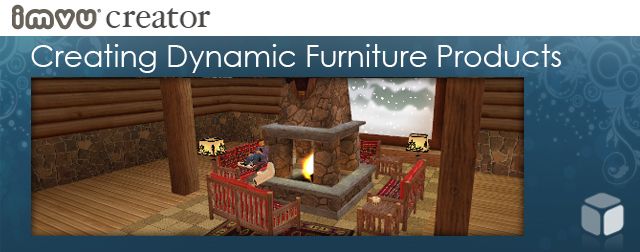
About Furniture
In IMVU a Furniture Product is any item that can be placed inside a Room. This means anything from a cup of tea to an aircraft carrier can be a Furniture item, which is pretty cool. Here are a few tips and tricks to making a truly dynamic furniture product, describing how they are constructed, how many avatars can interact with it, and how it may enhance any Room it is placed in.
What is a Dynamic Furniture Product?
Dynamic furniture is anything that creates an environment within itself. A simple example would be a Hot Tub, or any single furniture item that includes lots of avatar seat locations that work to encourage conversations between two or more avatars. Dynamic furniture items often include some large central element, a strong theme, and avatar poses that are unique to that particular product. These products can also work as dominant centerpieces for Room Bundles, and can often enhance an entire environment all by itself. 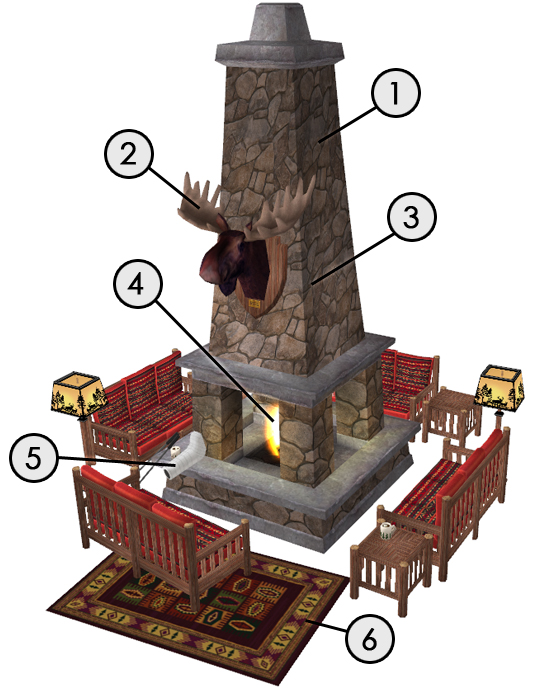 In the Lodge Fireplace example above, I have highlighted several details that help make this particular Furniture Product more dynamic then just creating a solitary sofa.
In the Lodge Fireplace example above, I have highlighted several details that help make this particular Furniture Product more dynamic then just creating a solitary sofa.
Create a Central Theme
When building a dynamic furniture item, think of its overall theme. Since Rooms and Furniture are purely the context for getting people to interact, just having a cluster of sofas might not be enough, especially if you could tell a story, or suggest a local within your design. For this example I decided to recreate the kind of fireplace that you might find in a cozy National Park Lodge, like Timberline, or the Old Faithful Inn. If you haven’t experienced it first hand, it is not hard to imagine just how pleasant sitting around an open fire is when it is blustery and cold outside. What better place to curl up for a nice chat. My job was to try and convey all that comfort and warmth with a basically static collection of furniture. How I arrange that furniture, what poses I include, and what additional props I add can really make a large furniture product extra special.
Does it Have a Front?
This may seem like a minor point, but it is important for your designs to have an obvious focal point. In this case I have added a large moose head to suggest there is a “front” to this environment, a place to focus your attention. This also helps suggest where to apply the most detail, rather than spreading bits of themeing all over the place, you can focus it in one place.
Do Your Textures Support the Materials You Are Attempting to Suggest?
Applying textures to a surface is a lot like wallpapering a box. The pattern on the paper is only important if your ultimate goal is to suggest that the object you are creating is supposed to be made out of the material printed on the paper. In this example I am using a tiling stone texture to suggest that this fireplace is made out of large river rocks. It is important to point out that I have taken great pains to make sure that the texture actually “wraps around” the surface so that a stone on one side of the fireplace actually continues around to the other side. I am sure you have seen examples of sloppy texture mapping where patterns, bricks, foliage, or stones are completely mismatched where they meet from one surface to the next. If you want to make your surfaces believable, take the extra time to make sure the textures match on all sides of an object.
Can you Add an Effect?
In this case I have derived my furniture product from the existing Fire Effect product (1859688). Using an existing Particles product I can include animated fire as a central element, and one that makes my fireplace all that more believable and dynamic. *Note: Particles are an Alpha functionality that does not currently work in the Create Mode Editor, but will in the future. For the time being deriving from an existing Particles product is your very best bet when including Particles in one of your products.
Unique Props Will Help Support the Story You Are Trying to Tell
Including props that help suggest a story will only help make your Furniture Product even better. In this case I have added mugs of hot chocolate, a pair of ski poles, and a leg cast which the avatar places its foot in when sitting at that end of the rustic couch.
The Real World is Asymmetrical
The computer makes it very easy to create furniture and environments that are filled with elements that are completely right angled and symmetrical. In reality, at least outside of pictures taken in Architectural Digest, our furnishings are seldom so slavishly geometric. No matter how neat we might be, all it takes is the presence of one human to knock that perfect end table out of alignment or skew that throw rug. Nature is organic and it often wins in the human battle for complete order. To make your environments more believable it is always good to mess them up slightly. In my example, I suggest that the avatar with the plaster cast has pulled the sofa up closer to the hearth so they can put their foot up closer to the fire. I have also very slightly skewed all the the furnishings so they have a definite order, but look like they were placed there by some person, and not by some computer. These very little choices can really add life and believability to your products.
![]()
Lots of Places to Sit
I have filled the product with click-able avatar seat locations. Although most are default standing and sitting poses, I have built a few poses that are unique to this particular product (seen as the gray colored avatars).
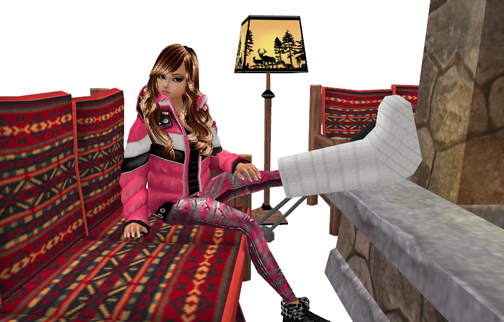
The most unique avatar seat is the one with the plaster cast. When sitting on this end of the sofa the avatars leg and foot (both male and female) are encased in the cast. Ski poles lay next to the cast suggesting they they may be used as impromptu crutches. I have also included a mug of hot chocolate to help finish out the scene.
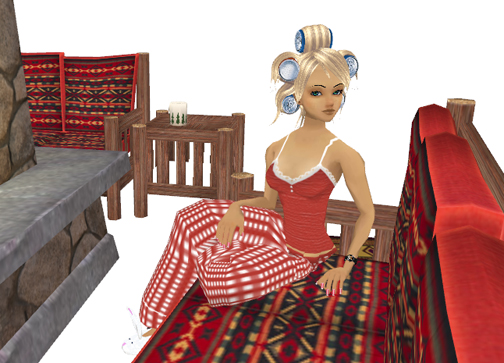
Directly across from the Cast Avatar is another unique seat that has the opposing avatar comfortably turned towards the other Cast Avatar. If there is an opportunity to suggest a more intimate conversation could happen when interacting with your furniture product take it by adding special avatar poses that enhance both the conversation and support the story you are trying to tell with your design.
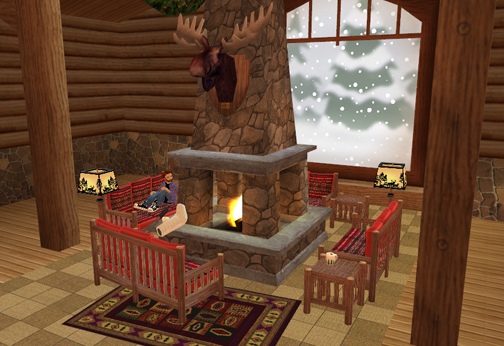
Dynamic furniture products can really make the look of a Room. Even simple environments can be greatly enhanced by the introduction of just one of these items, releaving some of the pressure to fill a room with “stuff”, and keeping focus on just a few luxurious details within it.
